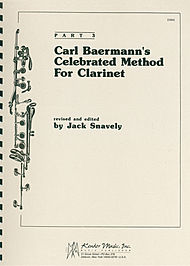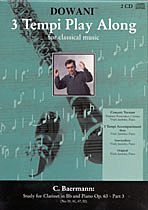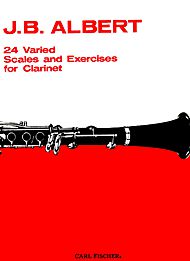Baermann clarinet scales
The Baermann clarinet scales, better known as the Carl Baermann, Complete Method for Clarinet, Third Division, Op. 63.
This scale method book is very commonly used with advanced high school students and in many conservatories and schools of music. It is an advanced book. If you are just familiar with the major scales (or do not know them all), you should consider working out of the Albert clarinet scales book first.
CYBER MONDAY 2025 CLARINET DEALS
Get 5% off a CLARINET, MOUTHPIECES, REEDS OR EVEN NEW MUSIC CAREER TRAINING
This is a special Clarinet-Now.com code for a limited time: CHRISTOPHERJONE
THIS BOOK WILL CHALLENGE YOU FOR THE REST OF YOUR LIFE – ARE READY FOR THE CHALLENGE? Baermann scales on Amazon.com
You have three very useful options or versions of this method (read explanations of the differences below):
The most commonly used Langenus version.
This Snavely version keeps all different scale types organized by key signature.
This Dowani version has a CD example with it.

This is how the Langenus version of Baermann clarinet scales is organized:
No. 1 – All twelve major scales with relative melodic minor scales going the range of the clarinet. Each scale completes with its arpeggio ascending to the top scale, tonic note.
This book does a good job of covering the enharmonic F# major/Gb major and relative melodic minor scales of d# minor/eb minor scales.
On page five, after the major and minor scales, you’ll find the chromatic scale from low e to super high c (above the treble staff five ledger lines and a space).
No. 2 – All major and minor broken chord passage
No. 3 – Diminished chords of the seventh – broken into several inversions of the chords
No. 4 – All major and minor interrupted scales – I usually call these “fours” as you ascend four notes at a time c d e f and then descend to the next scale tone d e f g, then e f g a, etc… These patterns are very helpful in learning your scales.
No. 4.5 – Broken chords – a different inversion and pattern than No. 2
No. 5 – Diminished chords of the seventh – a different variation from No. 3
No. 5.5 – Returning scales – These scales start with a interval of a third between the first two notes and a scale passage following. The pattern ascends and then descends. It only covers the 12 major scales
No. 6 – Chords of the seventh on the major scales only (minor chords of the seventh are not covered here)
No. 7 – Diverse chords
No. 8 – Scales in thirds (covers all major and minor keys)
No. 9 – Sixths
Mr. Baermann offers the advice here before No. 10-12 that no tempo is marked and that the player adapt these exercises to their ability. He also mentions that “the performer will scarcely be able to play this exercise right through.”
No. 10 – Octaves
No. 11 – Staccato and Trill Exercise – Four pages of sixteenth note articulation with numerous challenges of trill study
No. 12 – Exercise for Triplets – This is another four pages of sixteenth triplets
Baermann clarinet scales – as organized by Jack Snavely

Above, you see the commonly used Langenus version where many of us poor saps had to turn pages to work on all of the scale variations.
Mr. Snavely in this edition, has compiled all of the ‘C major’ scale patterns so you can cover that scale and then move to the next. Mr. Snavely has also added scales not available in the original Baermann book: whole tone, scales in 4ths, and natural/harmonic minor scales
Baermann clarinet scales – with CD example by Dowani

The CD accompanying this Baermann method gives you three tempi, slow, medium and fast to practice. Having the example of a professional clarinetist work through these scales for you to listen to and practice with is worth its weight in gold.
MOST IMPORTANT – WORK ON YOUR BAERMANN CLARINET SCALES !!!
Why do you practice the Baermann clarinet scales? Learn more about practicing scales here.
The Baermann scale book is pretty heavy. If you do not think you are ready for it, read about the Albert scale book here.


